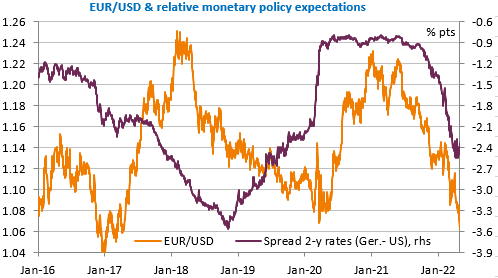Join EnergyScan
Get more analysis and data with our Premium subscription
Ask for a free trial here
1.0616 at the time of writing, possibly lower by the time of publication. The EUR/USD exchange rate has sunk below its 2020 lows. You have to go back to 2017 to find a lower level. The 2 main reasons are known: 1) the rise of risk aversion which resulted in a violent downward correction of the US markets and in particular the Nasdaq yesterday (-3.95%). At the same time, we are seeing a fairly sharp drop in long-term rates and thus a flattening of the yield curve once again: 2.77% for the 10-year, 2.57% for the 2-year. 2) Expectations of monetary tightening have continued to grow since the beginning of the year in favour of the USD at the expense of the euro, with the 2-year spread widening by 150bp, as shown in this chart. And the EUR/USD has very clearly reconnected to this spread.

The collapse in German household confidence, lower than the levels of spring 2020, will not help matters, although this is debatable insofar as it is probably the very strong rise in prices that is the cause, which would call for monetary tightening. Household confidence is also falling sharply in France, despite the measures taken by the government to reduce energy bills. Worries about purchasing power are compounded by concerns about the geopolitical situation.
The economic calendar is rather light today: trade balance and housing sales promises in the US and a speech by the ECB President in the late afternoon.
Get more analysis and data with our Premium subscription
Ask for a free trial here